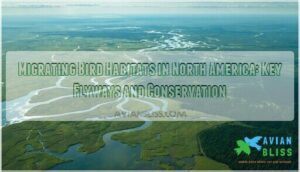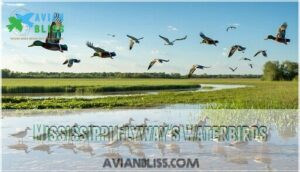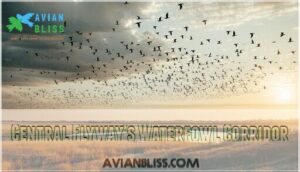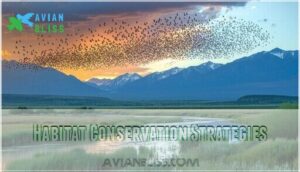This site is supported by our readers. We may earn a commission, at no cost to you, if you purchase through links.
 Migrating bird habitats in North America are defined by four major flyways: Atlantic, Mississippi, Central, and Pacific.
Migrating bird habitats in North America are defined by four major flyways: Atlantic, Mississippi, Central, and Pacific.
These natural highways guide billions of birds as they journey between breeding and wintering grounds. Each flyway hosts unique species—like songbirds in the Atlantic Flyway or waterfowl along the Mississippi.
Birds rely on stopover habitats, such as wetlands, prairies, and forests, for rest and refueling, making them essential for survival.
Protecting these spaces isn’t just for the birds—it benefits entire ecosystems. Next time you spot a flock overhead, imagine their epic journey and how every wetland or forest plays a tiny, critical part.
Table Of Contents
- Key Takeaways
- North America’s Flyways
- Migratory Bird Program Overview
- Habitat Conservation Strategies
- Frequently Asked Questions (FAQs)
- Where do North American birds migrate?
- What are the 4 flyways in North America?
- Where are the stopover sites for migratory birds?
- What state has the most migratory birds?
- Where do birds migrate in North America?
- What are the migratory birds routes in the US?
- What are the 4 flyways of North America?
- What North American bird has the longest migration?
- What are the effects of climate change on bird migration?
- How do migratory birds navigate their migration routes?
- Conclusion
Key Takeaways
- You can help protect migratory birds by supporting the preservation of wetlands, forests, and prairies, which are essential stopover habitats.
- Birds in North America migrate along four main flyways—Atlantic, Mississippi, Central, and Pacific—connecting breeding, wintering, and resting grounds.
- Climate change and habitat loss threaten migration routes, making conservation efforts crucial for their survival.
- By participating in citizen science and advocating for bird-friendly policies, you’re contributing to safeguarding bird habitats for future generations.
North America’s Flyways
You’ve probably heard about birds traveling incredible distances, but did you know their journeys often follow well-established routes called flyways?
Migratory birds traverse breathtaking flyways, nature’s highways, showcasing resilience and the vital role of preserving their habitats.
North America’s four main flyways – Atlantic, Mississippi, Central, and Pacific – guide millions of migratory birds each year, offering them efficient paths filled with essential stopover habitats.
Atlantic Flyway and Migratory Birds
Through the Atlantic Flyway, migratory birds like Red Knots and Wood Thrushes navigate key bird migration routes.
Red Knots and Wood Thrushes soar along the Atlantic Flyway, their journeys connecting vibrant habitats and breathtaking migrations.
Coastal habitats, such as Delaware Bay, offer essential stopovers where species refuel on horseshoe crab eggs.
Conservation efforts safeguard this remarkable species diversity, combating urban impacts and climate change to protect North America’s migratory bird habitats and guarantee future journeys remain possible.
Mississippi Flyway’s Waterbirds
The Mississippi Flyway bursts with life, guiding waterfowl and shorebirds through wetlands and floodplains.
It’s a lifeline despite habitat loss, pollution impacts, and avian diseases. Conservation teams battle climate change, seeking to sustain these vital migratory bird habitats becomes Conservation teams battle climate change, working to sustain these essential migratory bird habitats.
- Over 40% of waterfowl rely on this route.
- Wetland habitats support rest and refueling.
- Key species: Mallards and Killdeer.
- Seasonal migrations inspire awe.
Central Flyway’s Waterfowl Corridor
The Central Flyway is one of North America’s most essential migratory bird habitats, stretching across the Great Plains and linking Canada to the Gulf of Mexico.
From Nebraska staging areas to the Prairie Potholes and Playa Lakes, this corridor supports millions of waterfowl, including ducks, geese, and Sandhill Cranes.
The Platte River is a critical stopover during their exhausting journeys, but conservation challenges like habitat loss demand urgent action.
Effective waterfowl management guarantees these ecosystems thrive, securing food and rest for migrating birds.
Understanding bird identification methods is essential for monitoring these populations effectively.
Protecting the Central Flyway means safeguarding bird migration itself—a legacy of beauty and balance for future generations.
Pacific Flyway’s Shorebirds and Songbirds
Across the sweeping Pacific Flyway, migratory bird habitats host an awe-inspiring show.
Shorebirds like sandpipers and plovers rest at coastal stopovers, such as Grays Harbor, while songbirds, including the Rufous Hummingbird, thrive in inland habitats during migration.
You’ll marvel at the synchronized migration timing of species interactions.
Yet, conservation challenges loom, with wetlands and beaches under threat, highlighting the need for preserving these delicate ecosystems to safeguard bird migration and the Pacific Flyway’s pivotal role in biodiversity.
Migratory Bird Program Overview
Through the Migratory Bird Program, you’re helping safeguard North America’s fascinating migratory birds.
This initiative tracks bird populations, supports essential Research Initiatives, and enforces conservation laws. Program Goals include protecting migration habitats and bolstering bird habitats across regions.
By offering grant programs, fostering Conservation Partnerships, and engaging the public, it guarantees these incredible species thrive.
Protecting these birds often requires international conventions for habitat preservation.
With diverse Funding Sources, the program inspires Public Engagement to help preserve the skies you share with these extraordinary travelers.
Habitat Conservation Strategies
You play a pivotal role in protecting bird habitats by understanding how breeding, wintering, and migration areas support survival.
Practical conservation strategies focus on preserving these key environments, ensuring birds have safe spaces to rest, feed, and thrive year-round, which involves preserving these areas to support bird survival.
Importance of Breeding, Wintering, and Migration Habitats
Breeding habitats are nurseries for young birds, boosting breeding success in thriving environments.
Wintering grounds guarantee winter survival with food and shelter.
Migration habitats, like pit stops on a road trip, provide stopover sites for refueling across flyways.
Understanding nesting habitat products can improve breeding success.
Habitat connectivity ties it all together, helping birds navigate climate impacts and reach breeding grounds or wintering grounds safely.
Strategic Habitat Conservation Approaches
Strategic habitat conservation is all about seeing the forest and the trees—literally.
It combines landscape conservation with adaptive management to safeguard migrating bird habitats across North America.
By focusing on habitat prioritization and threat mitigation, this approach guarantees long-term success.
Key actions include monitoring effectiveness to fine-tune strategies, fostering conservation partnerships to pool resources, and prioritizing habitat restoration.
Whether it’s saving a wetland for whooping cranes or managing stopovers for songbirds, bird habitat management thrives through collaboration and flexibility.
Think of it as giving birds a well-managed hotel on their long journeys.
Collabor
Protecting bird habitats starts with teamwork. Working together through Habitat Partnerships and International Agreements strengthens conservation efforts for migratory birds.
- Collaborative Research: Scientists join forces to uncover migration secrets and improve bird habitats.
- Citizen Science: Engage communities to track bird migration, adding valuable data.
- Policy Influence: Advocate for laws safeguarding bird migration corridors.
To further bolster these efforts, the Army manages lands as essential refuges. When everyone pitches in, north American birds thrive.
Frequently Asked Questions (FAQs)
Where do North American birds migrate?
North American birds migrate along four main flyways—Atlantic, Mississippi, Central, and Pacific—traveling thousands of miles.
They seek food, nesting sites, or warmer climates, moving from breeding grounds in the north to southern wintering areas, which involves traveling along these flyways.
What are the 4 flyways in North America?
The four flyways in North America are the Atlantic, Mississippi, Central, and Pacific flyways.
These migration routes guide birds along natural landmarks like coasts and rivers, connecting breeding, wintering, and stopover areas across the continent, which is a complete concept that encompasses various bird migration patterns.
Where are the stopover sites for migratory birds?
Picture thousands of wings pausing mid-journey—Chesapeake Bay, Delaware Bay, Great Salt Lake, and Nebraska’s Platte River steal the show, offering essential pit stops for migratory birds needing rest, food, and protection during their incredible travels.
These locations provide essential pit stops for migratory birds, giving them the protection they need during their journeys.
What state has the most migratory birds?
Texas steals the spotlight with the highest number of migratory bird species, thanks to its diverse ecosystems and prime location along both the Central and Mississippi Flyways.
It’s like a birdwatcher’s paradise year-round!
Where do birds migrate in North America?
Birds migrate across North America to various regions, from Alaska’s boreal forests to the Gulf Coast’s wetlands.
They follow four main flyways, adapting routes for food, shelter, and survival, often crossing vast distances effortlessly, utilizing these pathways for survival.
What are the migratory birds routes in the US?
Imagine highways in the sky: birds follow four main routes in the U.S.—the Pacific, Central, Mississippi, and Atlantic Flyways.
Each uses rivers, coasts, and mountains as navigation aids during their incredible migrations.
What are the 4 flyways of North America?
North America has four main flyways: the Atlantic, Mississippi, Central, and Pacific.
These paths guide millions of migrating birds annually, following coastlines, rivers, and mountains, offering essential rest stops along the way, which are complete concepts and essential for their journey.
What North American bird has the longest migration?
The Arctic Tern sets the bar high, traveling about 44,000 miles yearly between its Arctic breeding grounds and Antarctica.
It’s basically nature’s ultimate world traveler—talk about racking up frequent flyer miles!
What are the effects of climate change on bird migration?
Climate change shifts migration timing, routes, and habitats by altering food availability and weather.
Warmer temperatures confuse birds’ instincts, disrupt stopover sites, and increase risks like storms, causing survival challenges on their incredible seasonal journeys, which involve incredible feats of endurance.
How do migratory birds navigate their migration routes?
It’s like a built-in GPS—migratory birds rely on the sun, stars, Earth’s magnetic field, and landmarks to navigate.
Some even use their sense of smell, proving nature’s navigators are smarter than they appear!
Conclusion
Did you know the future of migrating bird habitats in North America depends on you taking action?
Protecting wetlands, forests, and prairies guarantees safe stopovers for billions of birds and strengthens entire ecosystems.
By supporting conservation efforts and sustainable practices, you’re preserving biodiversity and contributing to healthier environments.
Next time you see birds traversing their flyways, remember—every habitat we save helps their epic journeys continue.
Small steps today make lasting impacts tomorrow.








